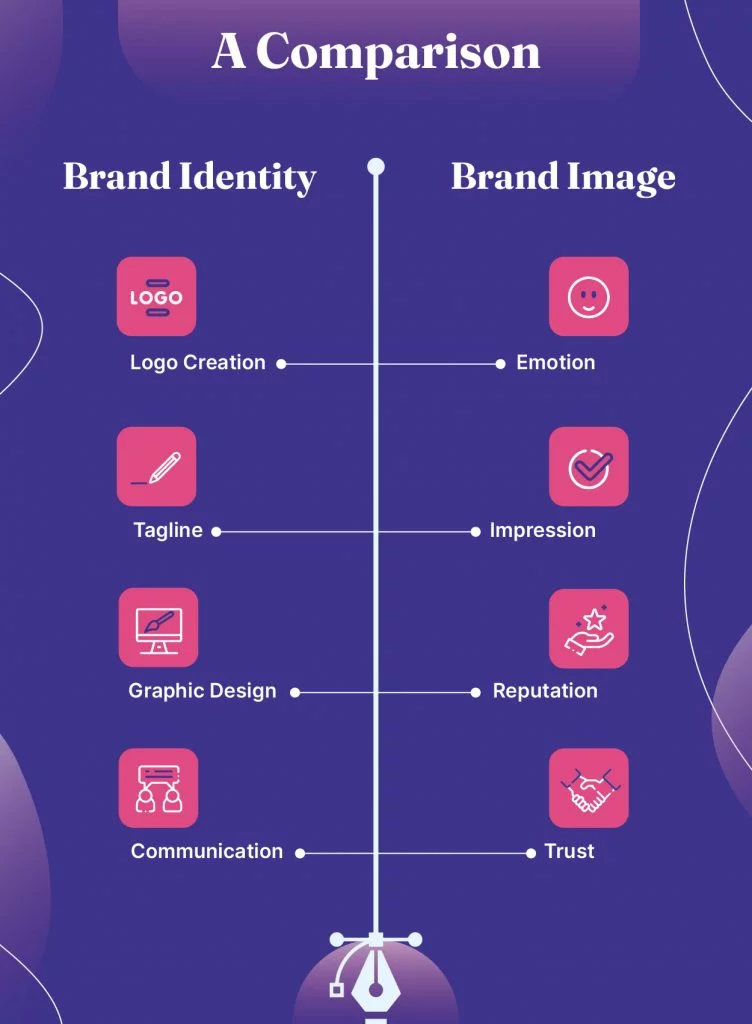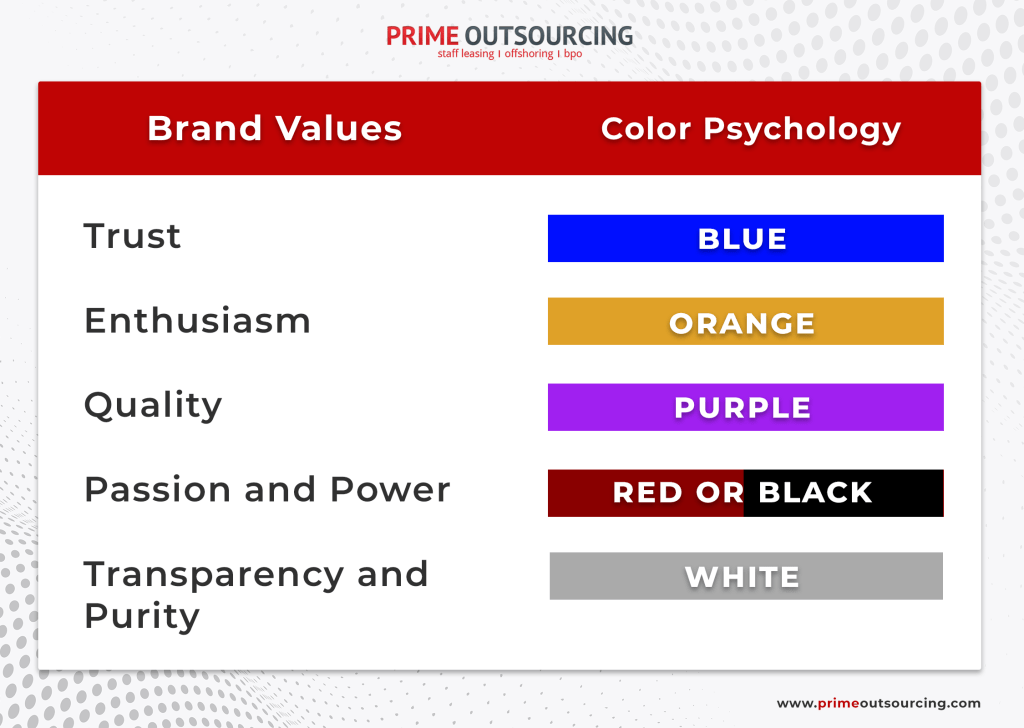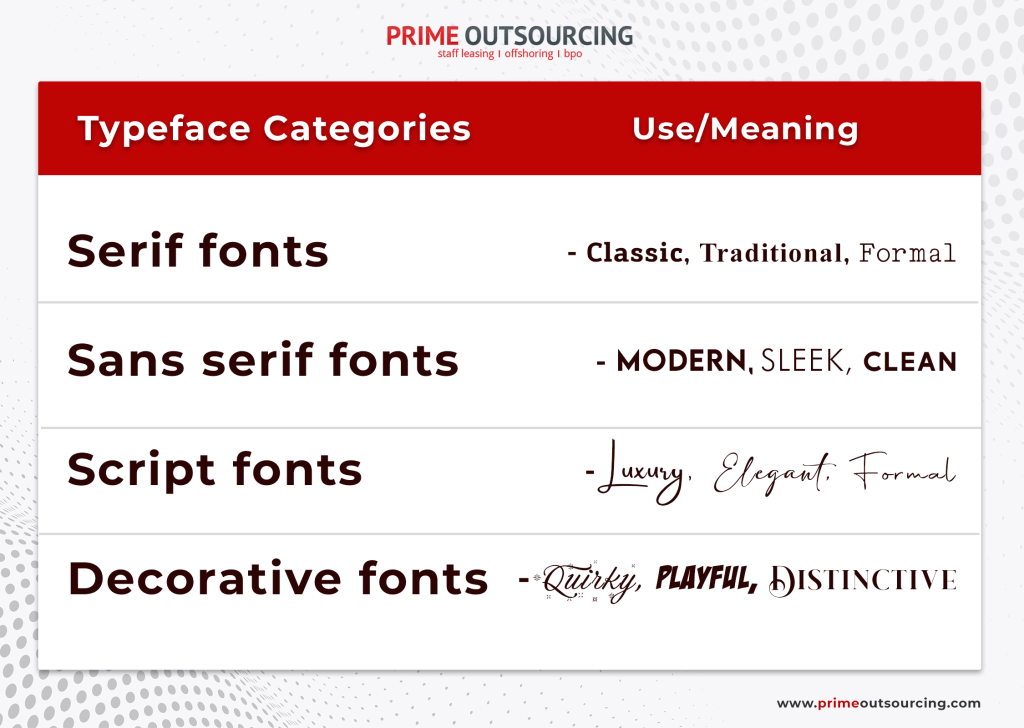
Brand image is as significant as your business strategies. A brand image is a discernment that people hold in a company. It encompasses values, reputation, and identity. It shapes consumer preferences, builds trust, and fosters loyalty. A strong brand image evokes emotions, establishes credibility, and differentiates from competitors. Companies must consistently adapt to changes, communicate, and maintain their brand image. It is a continuous process that requires wariness, adaptation, and addressing challenges promptly. A compelling brand image leaves a lasting impression and helps drive success.
Just like anything else, a business needs an identity to stand out and an image that will be perceived by its target audience. A brand may appear to be professional and serious, casual and playful, elegant and sophisticated, or even adorable and friendly. It will all depend on how your vision and mission align with it and your brand’s overall aesthetic and values.
“Brand image is important for any business. When consumers purchase a product or product, they are not just buying a product or service; they are buying what your brand stands for.” —Forbes Agency Council
When we establish a business, we are commonly too overwhelmed with what we need to accomplish. Oftentimes, we overlook the simple and basic steps that are essential for your brand’s success. Whether you are a novice or an expert, this blog will help you mold your brand image in four comprehensive ways to contribute or embed in your business’s activities.
1) Identify your target audience
A business is always about the customers. The content you publish should not only revolve around you but also supply relevant information, entertainment, or discoveries to your target market. Understanding the needs and wants of your market is also vital to successfully suffice it through your offering. It is essential to pinpoint your target market to promote your goods or services well. Understanding the precise demographic who are interested in what you offer is necessary for this. You may effectively reach and engage the correct audience by identifying your target market and modifying your marketing initiatives, messaging, and methods accordingly. By doing this, you eventually increase your chances of success and make the most of your available resources.

Understanding Your Target Audience
By understanding and focusing on specific customer segments, businesses can optimize their efforts, tailor their strategies, and meet the unique needs of their target audience, leading to greater success and differentiation in the market. Understanding the target audience also enables relevance and personalization, efficient resource allocation, effective communication, product creation, market opportunity identification, and customer relationship building. Understanding the target market helps organizations create their strategies and products to meet those needs, which ultimately helps in leading at the competitive edge.
To avoid term puzzlement, the term target market talks about customers or consumers who are likely to purchase your products or services. On the other hand, the target audience talks to the segmented group of people who are being served in your advertising campaigns. It is safe to say that the target audience is a subset of your target market.
A simple guide on how to identify your target audience is by target segmentation. There are four basic types of target segmentation. These are demographic, psychographic, geographic, and behavioral segmentation.
- Demographic segmentation emphasizes your target market’s data or demographic variables such as age, amount of income, occupation, marital status, gender preference, sex, family size, race, education, nationality, or even religious beliefs.
- Psychographic segmentation concentrates on psychological characteristics including personality, opinions, personal interests, social status, daily activities, lifestyle, and attitudes.
Demographics show who your buyers are and psychographics show why they buy.
- Geographic segmentation separates a market into various geographic areas according to geography, climate, population density, or cultural preferences.
- Behavioral segmentation is categorized based on market activities, behaviors, and usage patterns. It analyzes consumer interactions with goods and services, purchasing patterns, brand loyalty, decision-making methods, and responses to marketing stimuli.
Target segmentation is crucial for businesses because it enables them to spend resources more effectively, provide individualized and positive experiences for customers, boost customer satisfaction, and increase marketing effectiveness.

Evolving and Adapting Your Brand Image
The brand image does not only revolve around the business itself but also its target market. In a dynamic marketplace, brands must evolve to stay relevant. Some key considerations include market research, assessing brand positioning, embracing digital transformation, updating visual identity and messaging, integrating sustainability, and continuous evaluation. By adapting to changing consumer preferences and market dynamics, brands can maintain relevance, engage their target audience, and stay ahead of the competition. In business, it is always essential to adapt the present-day business processes and tactics to stay on top.
Businesses that fail to address these constant practices of digital transformation and evolution are more likely to fail and not grasp more potential markets in the future. For traditional brick-and-mortar enterprises, conventional activities can still be utilized just as long as it is integrated with modernized brand practices to keep striving in the business sector. Your brand identity is most noticeable to your target audience if they appear on digital platforms, and social media sites as the most active market are found there. This is why your brand image should also be modern and relevant not only to your core values but to the needs of your market as well.
2) Establishing Brand Values
Brand values are the core beliefs and principles that a company follows as a guide for its culture, actions, and relationships within and outside the organization. This defines what the brand stands for and that is why establishing plausible brand values is extremely important to put up a cohesive brand image. Brand values serve as a compass for decision-making. It is essential to create a solid foundation for the organization’s specific ideals to align with the company’s vision, inspire employees, and resonate with the market. This short guide will explore key steps to establish brand values that reflect the essence of your business, foster authenticity, and drive long-term success.
Crafting a brand statement
Making a brand statement should be succinct. A business needs to encompass a message that your target market will see and support you. It includes your values, mission, and vision. Your brand statement may also be one reason your customers keep choosing your brand after all. On top of that, a brand statement develops a concise assertion of your values, beliefs, and what makes you exceptional among all.
- Mission
The purpose of a mission statement in a business is to succinctly communicate the values, core purpose, and aspirations of the brand. A mission statement serves as a guiding statement that defines the organization’s overall direction, informs decision-making, and inspires employees, customers, and stakeholders.
- Vision
A vision statement in a business is to provide a clear and inspiring perspective of the future state and long-term goals that the company aims to achieve. It serves as a guiding beacon, aligns stakeholders towards a shared vision, and motivates employees to work towards a common purpose and result. A vision statement also consists of feasible plans and outcomes as to what is probable and can be attained in a certain amount of time. It helps set realistic goals for a business to strive and be more motivated toward fulfilling the organization’s purpose. The company’s vision can also contribute to shaping the brand image and what the target market will expect from the company hereafter.
- Values
Values in a company refer to the fundamental principles and beliefs that lead the actions, behavior, and decision-making of its employees. Values serve as a moral compass in molding the company’s ethical culture, relationships, and interactions with stakeholders. Values provide a foundation for harmony, integrity, and the establishment of a positive and ethical organizational identity and the entire brand image.
Implementing brand positioning strategies
Brand positioning strategies are relevant mainly if you belong to an industry with many competitors. However, it does not mean that a brand with fewer competitors should not bother making brand positioning strategies. Both need to establish a strategy to be able to build clarity on why you are the best option in the market. Brand positioning helps you set your brand apart from others and make it stand out. The implementation of brand positioning strategies is the most crucial, as after planning, here comes the actual work. A well-executed brand positioning strategy ensures consistent and targeted messaging that resonates with your target audience. By clearly articulating your brand’s positioning, you can effectively communicate the value your brand offers.
Strengthening brand storytelling and communication
Communication is one of the primary keys to connecting with your target market but a lot neglected that good brand storytelling does its job too. Brand storytelling comprises emotionally evoking activities to touch the foundational human aspect of the market aside from their practical mindset of just focusing on the product offering alone. It is valuable that the target market also feels emotionally attached to the values of the brand which creates a positive connotation to its overall brand image. It also helps your brand stay relevant in a rapidly changing market. By understanding your target audience’s evolving preferences and needs any business can adapt, adjust, and strengthen its positioning strategy to maintain brand image, relevance, and appeal to the public.
3) Building a compelling brand identity
Image is a huge factor in a brand. It depicts how you would like to be perceived by your target audience and the market per se. Some brands have established luxurious personalities while others appear to be affordable or cheap. This is due to several factors that affect our brains psychologically. There is quite a difference between brand identity and brand image which is easily misinterpreted by some.
Brand identity is the set of visual characteristics you use for your brand. This includes the aesthetic style, color associations, shape connotations, or even language tone. It’s the mere surface and when you go beyond, that is when brand image takes place. Brand image is your overall set of values, beliefs, and principles that shape the business activities and actions as a whole.
“Your brand identity is often your first chance to establish your brand image. Invest in it from the start, and pay careful attention to the feedback you receive from friends, colleagues, and customers.” —Jenna Romano of Wix

Designing a Memorable Visual Identity
Colors
Choosing a color based on a brand is not just about your favorite ones. Different colors portray various psychological meanings in our minds. Follow these steps to select the best color for your brand:
- List down your brand values
It is vital to know what your business stands for. Your brand message must be clear in written and visual form to avoid confusion. You may also refer to the psychology of color to guide you with the fundamentals of color and its negative or positive connotations.
- Research colors associated with your values
Once you have a list of your values, check some studies about color psychology and read which color portrays your brand’s value the best. As Carl Jung, a Swiss psychiatrist quoted,
Color is the native language of the subconscious.
- Select the best color that suits your brand best and pick the shade you prefer to use
Each color has a wide range of shades that differ in hue, tone, value, and saturation. Try a color picker and play around with the shades available. Your hex code will define your color values or the amount of RGB (red, green, blue) in your selected color.
- Mix and match your brand colors
Unless you want your brand to be represented with one color then you can skip this step. But usually, a brand may use 1-3 primary colors to symbolize their brand. Mix and match other colors with your main brand color to see what looks good together. If you’re having trouble, you can use the traditional color wheel to guide you through or an online tool to mix and match.

Typeface and Font
Typography is also a crucial part of your brand image. It yields emotion, tone, and brand messages, therefore, choosing the appropriate typography is essential for any business. When choosing a typeface, you want to explore and learn about the basics like the negative and positive connotations as well as its proper usage. If you are having a difficult time choosing, your designer may help you pick the best font to fit your brand identity. As to what your business message suggests, select a typeface and font that best suits the brand message. Check the guideline below to simply give you a picture in selecting the typeface and font for your brand.

Logo, icons, and imagery
A well-designed logo, icons, and imagery can create instant recognition, recall, and retention for a brand. Logo, specifically becomes a visual identifier that helps customers easily associate it with the brand. Logos, icons, and imagery can convey the values, personality, and identity of a brand. A professionally designed color with visual elements thoroughly chosen, can evoke emotions and establish the desired brand image.
Designers who create logos and icons contribute to the professionalism and credibility of the brand and its brand image. It can instill trust in customers convey a sense of reliability and quality and ensure consistency in brand communication. These components act as a visual anchor that ties together various brand touchpoints, such as packaging, advertisements, websites, and social media profiles, which creates a cohesive brand image and experience. Logos, icons, and imagery can set a brand apart from competitors. By using unique and distinctive visual elements, a brand can establish its own visual identity and stand out in a crowded marketplace.

4) Being consistent with your brand image
Consistency is vital for a cohesive brand image. It builds recognition, establishes trust, and reinforces brand identity. It creates a cohesive and memorable experience for customers, fostering loyalty and differentiation in a competitive and fast-changing market. Consistent delivery of promises, quality, and experiences builds positive relationships and trust with customers. It also demonstrates reliability, professionalism, and a commitment to meeting customer expectations or even exceeding them. When customers consistently have positive interactions and experiences with your brand, they are more likely to become repeat buyers and advocates.

Consistent brand identity
First impressions last. Your audience would not see your values, purpose, and mission, firsthand. What appeals to the eye leaves a lasting impression. Choose colors that faithfully represent your brand and its image. If you want to be associated with being more eccentric and inventive, try orange. Or if you want to suggest joy and excitement, try yellow. Just be sure to make wise and appropriate color selections. A consistent brand identity guarantees that your visual elements, messaging, and customer experiences align harmoniously across all customer touchpoints. This cohesive approach establishes brand recognition, builds trust with customers, reinforces your brand’s extraordinary qualities, and helps you stand out among other competitors in the market.
Your target market can easily recognize and comprehend your brand with brand voice and tone upon communicating. Just like in day-to-day conversations, brands also need to set an appropriate tone in delivering their messages. The tone may be formed according to the nature of the business and its target audience. For the younger market, a casual, playful, fun, and friendly tone is the most suitable one to utilize as this appeals to their age. For professionals, a more formal and comprehensive tone is applicable.
A consistent tone of voice in a brand assures that your communication style remains uniform across different platforms, media, touchpoints, and interactions. This consistency creates a distinct and reliable brand persona. It may positively foster trust, build relationships, and strengthen your brand image and brand identity. Consistency in tone of voice also establishes a cohesive and memorable brand image, making it easier for customers to connect with your brand and set it apart from the competitors.
Consistent delivery of promising services
Consistent delivery of promising services is preeminent in a brand’s success. You may have strategically come up with a powerful brand identity but it will all be put to waste if the products or services you offer are not as good as you market it. Customers spend money to fulfill their needs and preferences, thus a company needs to deliver what they promised and meet customer expectations. In being consistent, you are building a standard. A standard of what is beneficial, reliable, and of great quality on the customer’s end. What they receive from the company should not be compromised, after all, products and services are meant to solve a problem, provide entertainment, and suffice the needs of the market.
Consistency builds trust, enhances customer satisfaction, fosters loyalty, and strengthens brand reputation. By consistently meeting or even better, exceeding the expectations of the customers, brands can empower themselves, generate positive word-of-mouth, and build a solid foundation for long-term success in the industry they belong.
Consistent positive brand experience
Maintaining a positive brand experience is quite challenging. You cannot guarantee a positive experience for daily business transactions or every time a customer tries to avail of your product and service offerings. It is something that you cannot predict nor plan since every brand experience differs from every customer you may have. However consistent positive brand experiences are essential for building strong customer relationships and brand loyalty. By consistently delivering exceptional products, services, and interactions, brands create a reliable and enjoyable customer journey.
This consistency promotes trust, satisfaction, and emotional connections, leading to repeat business transactions, customer advocacy, and a positive brand image and reputation. For that reason, a brand should always work on providing a positive and memorable customer experience by executing the initial three elements of a consistent brand image.
In conclusion, a cohesive brand image maintains consistency across all elements of its identity, including visual representation, messaging, tone of voice, delivery of service, and maintaining a positive customer buying journey. Hiring reliable and skilled designers and developers can also help in building the brand identity of a company. By establishing and upholding a strong and consistent brand image, companies can build recognition, trust, and loyalty among customers. These four comprehensive and easy ways to create a cohesive brand image will surely contribute to the company’s overall business process and improve its activities.
A cohesive brand differentiates itself in the market, creates a memorable and meaningful customer experience, and lays the foundation for long-term success. It is through this cohesive approach that brands can efficiently connect with their target audience, foster strong relationships, and thrive in today’s competitive and advanced business environment.


